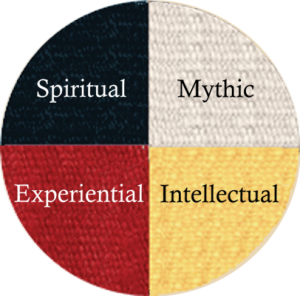 Different ways of knowing, learning about, and responding to the natural world are central to Tapestry’s mission, because these are important processes of Indigenous Knowledge. Of course, in the natural world, the ways that people and animals come to understand things are not separated into separate and discrete categories. Instead, different types of information are combined, or integrated, which maximizes a learner’s ability to respond effectively and appropriately to the world around them.
Different ways of knowing, learning about, and responding to the natural world are central to Tapestry’s mission, because these are important processes of Indigenous Knowledge. Of course, in the natural world, the ways that people and animals come to understand things are not separated into separate and discrete categories. Instead, different types of information are combined, or integrated, which maximizes a learner’s ability to respond effectively and appropriately to the world around them.
Contemporary culture understands the inherent power of diverse people and ideas, but focuses on content (subject matter) rather than process (ways of knowing) when it thinks about diversity. The result is that important multidisciplinary and multicultural efforts exist, but still primarily rely on intellectual ways of knowing and are therefore only superficially diverse. We have learned that a focus on different ways of knowing and learning permits us to hold the center on creating, sustaining, and integrating real diversity of information in our work and permits the emergence of Indigenous Knowledge.
People in contemporary, modern culture use most or all of the different ways of knowing and learning — as do all human beings — but are uncomfortable with those that are not intellectual and often will not acknowledge them or use them in decision-making. So they have forgotten how to use them consciously and wisely, and how to integrate them with each other. The ancient relationship between humans and the earth are recorded in many different forms — including visual art, music, ritual, and story — because humans of other times were well-versed in gathering, integrating, and applying more than one or two ways of learning. People of today must learn how to use the whole palette of human understanding again, to access the records of human-nature relationship left us by others as well as to understand the different voices of nature for themselves.
The model we use links the directions of the Circle with specific ways of knowing and learning in this way:
- East is associated with Intellectual Ways of Knowing and Learning.
- South is associated with Experiential Ways of Knowing and Learning.
- West is associated with Spiritual Ways of Knowing and Learning.
- North is associated with Mythic Ways of Knowing and Learning.
- The Center is associated with Integrated Ways of Knowing and Learning.
You may use the table below to explore the directions, their associated ways of knowing and learning, and an example that uses tornadoes to illustrate the power of using and integrating all the different ways of learning.
